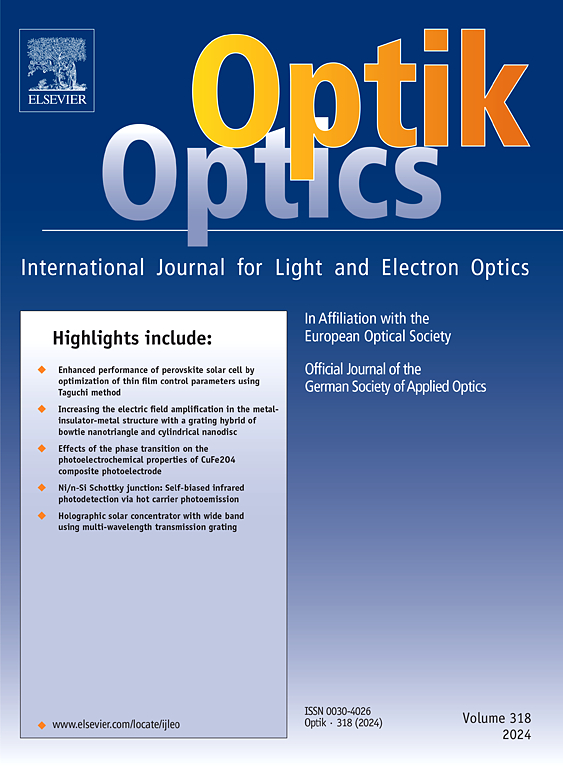掺杂锑增强TiO2基紫外探测器的响应性
IF 3.1
3区 物理与天体物理
Q2 Engineering
引用次数: 0
摘要
二氧化钛具有出色的光电特性、高稳定性和低成本制造等特点,因此受到了广泛关注,成为各种能源相关应用的尖端材料。然而,TiO2 在紫外范围内的带隙能和低激发态促使研究人员加入不同的掺杂元素来优化其性能。我们利用化学沉积技术展示了在二氧化钛中加入锑(Sb)作为紫外光探测器的效果。我们分析了未掺杂和掺杂器件(Sb:TiO2)的结构、光学和电学特性。在波长为 365 nm、功率强度为 130 μW 的紫外线照射下,我们显著提高了器件的灵敏度。与未掺杂器件(TiO2-Ns/PSi/Ag)相比,掺杂器件(Sb:TiO2-Ns/PSi/Ag)表现出更优越的光响应和性能。该器件在 -5V 至 5V 的电压范围内表现出肖特基特性,显示出很强的响应能力和出色的电气性能。在 3 V 和 5 V 偏置电压下进行的 I-V 分析表明,该器件具有出色的响应性和灵敏度。性能最佳的优化器件(Sb:TiO2-Ns/PSi/Ag)与未掺杂的 TiO2 器件(TiO2-Ns/PSi/Ag)相比,具有最高的光电探测器参数:响应率为 23.5 A/W,量子效率为 8 × 103%,灵敏度为 685.71%,增益为 7.86,检测率为 1.97 × 1012 Jones,净电导率为 9.0 × 10-14 W,而未掺杂的 TiO2 器件(TiO2-Ns/PSi/Ag)的响应率为 15.在 5 V 偏置电压的紫外光(波长为 365 nm,功率强度为 130 μW)照射下,掺入锑的 TiO2 器件的响应率为 15.0 × 10-14 W,而未掺入锑的 TiO2 器件(TiO2-Ns/PSi/Ag)的响应率为 15.4 A/W,量子效率为 5.22 × 103%,灵敏度为 420.81 %,增益为 5.21,检测率为 1.25 × 1012 Jones,NEP 为 1.42 × 10-13 W。这些发现强调了掺杂锑对 TiO2 光探测的重要影响,与传统的基于 TiO2 的器件相比,掺杂锑可提高光响应度和灵敏度,从而使 Sb:TiO2 结构成为紫外传感应用的理想候选材料。本文章由计算机程序翻译,如有差异,请以英文原文为准。
Responsivity enhancement of TiO2 based UV photodetector by antimony doping
The excellent photoelectric properties, high stability, and low-cost fabrication have gained TiO2 tremendous attention as a cutting-edge material for various energy-related applications. However, the bandgap energy in the UV range and the low excited states of TiO2 have urged researchers to incorporate different dopant elements to optimize its properties. We demonstrated the effect of antimony (Sb) incorporation to TiO2 as UV photodetector using chemical bath deposition technique. The structural, optical, and electrical behaviour of undoped and doped devices (Sb:TiO2) were analyzed. Under UV irradiation at a wavelength of 365 nm and a power intensity of 130 μW, we achieved remarkable enhancement in device sensitivity. Compared to an undoped device (TiO2-Ns/PSi/Ag), the doped device (Sb:TiO2-Ns/PSi/Ag) demonstrated superior photoresponse and performance. The device exhibited Schottky characteristics within a voltage range of -5V to 5 V, demonstrating strong responsiveness and excellent electrical behaviour. I-V analysis at bias voltages of 3 V, and 5 V revealed outstanding responsivity and sensitivity. The best optimized performance device (Sb:TiO2-Ns/PSi/Ag) demonstrate highest photodetector parameters of responsivity as 23.5 A/W, quantum efficiency as ∼8 × 103%, sensitivity as 685.71 %, gain as 7.86, detectivity as 1.97 × 1012 Jones, and NEP as 9.0 × 10–14 W compared to that of the undoped TiO2 device (TiO2-Ns/PSi/Ag) with responsivity of 15.4 A/W, quantum efficiency as 5.22 × 103%, sensitivity as 420.81 %, gain as 5.21 detectivity as 1.25 × 1012 Jones, and NEP as 1.42 × 10–13 W, as a results of Sb incorporation to TiO2 both under UV light illumination (wavelength 365 nm and power intensity of 130 μW) at 5 V bias voltage. These findings underscore the significant impact of Sb doping on TiO2 for photodetection, leading to enhanced photo-responsivity and sensitivity compared to conventional TiO2-based devices, thereby establishing Sb:TiO2 structures as promising candidates for UV sensing applications.
求助全文
通过发布文献求助,成功后即可免费获取论文全文。
去求助
来源期刊

Optik
物理-光学
CiteScore
6.90
自引率
12.90%
发文量
1471
审稿时长
46 days
期刊介绍:
Optik publishes articles on all subjects related to light and electron optics and offers a survey on the state of research and technical development within the following fields:
Optics:
-Optics design, geometrical and beam optics, wave optics-
Optical and micro-optical components, diffractive optics, devices and systems-
Photoelectric and optoelectronic devices-
Optical properties of materials, nonlinear optics, wave propagation and transmission in homogeneous and inhomogeneous materials-
Information optics, image formation and processing, holographic techniques, microscopes and spectrometer techniques, and image analysis-
Optical testing and measuring techniques-
Optical communication and computing-
Physiological optics-
As well as other related topics.
 求助内容:
求助内容: 应助结果提醒方式:
应助结果提醒方式:


